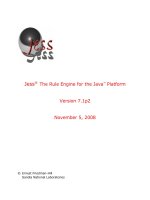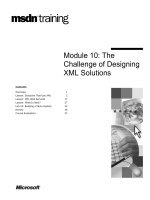The Simple API for XML (SAX)
Bạn đang xem bản rút gọn của tài liệu. Xem và tải ngay bản đầy đủ của tài liệu tại đây (547.5 KB, 8 trang )
Section 4 – The Simple API for XML (SAX) Tutorial – XML Programming in Java
16
Section 4 – The Simple API for XML (SAX)
The Simple API for XML
SAX is an event-driven API for parsing XML
documents. In our DOM parsing examples, we
sent the XML document to the parser, the parser
processed the complete document, then we got a
Document object representing our document.
In the SAX model, we send our XML document to
the parser, and the parser notifies us when certain
events happen. It’s up to us to decide what we
want to do with those events; if we ignore them, the
information in the event is discarded.
Sample code
Before we go any further, make sure you’ve
downloaded our sample XML applications onto
your machine. Unzip the file xmljava.zip, and
you’re ready to go! (Be sure to remember where
you put the file.)
SAX events
The SAX API defines a number of events. You can
write Java code that handles all of the events you
care about. If you don’t care about a certain type of
event, you don’t have to write any code at all. Just
ignore the event, and the parser will discard it.
Tutorial – XML Programming in Java Section 4 – The Simple API for XML (SAX)
17
A wee listing of SAX events
We’ll list most of the SAX events here and on the
next panel. All of the events on this panel are
commonly used; the events on the next panel are
more esoteric. They’re part of the HandlerBase
class in the org.xml.sax package.
• startDocument
Signals the start of the document.
• endDocument
Signals the end of the document.
• startElement
Signals the start of an element. The parser
fires this event when all of the contents of the
opening tag have been processed. That
includes the name of the tag and any attributes
it might have.
• endElement
Signals the end of an element.
• characters
Contains character data, similar to a DOM
Text node.
More SAX events
Here are some other SAX events:
• ignorableWhitespace
This event is analogous to the useless DOM
nodes we discussed earlier. One benefit of this
event is that it’s different from the character
event; if you don’t care about whitespace, you
can ignore all whitespace nodes by ignoring
this event.
• warning, error, and fatalError
These three events indicate parsing errors.
You can respond to them as you wish.
• setDocumentLocator
The parser sends you this event to allow you to
store a SAX Locator object. The Locator
object can be used to find out exactly where in
the document an event occurred.
Section 4 – The Simple API for XML (SAX) Tutorial – XML Programming in Java
18
A note about SAX interfaces
The SAX API actually defines four interfaces for
handling events: EntityHandler, DTDHandler,
DocumentHandler, and ErrorHandler. All of
these interfaces are implemented by
HandlerBase.
Most of the time, your Java code will extend the
HandlerBase class. If you want to subdivide the
functions of your code (maybe you’ve got a great
DTDHandler class already written), you can
implement the xxxHandler classes individually.
<?xml version="1.0"?>
<sonnet type="Shakespearean">
<author>
<last-name>Shakespeare</last-name>
<first-name>William</first-name>
<nationality>British</nationality>
<year-of-birth>1564</year-of-birth>
<year-of-death>1616</year-of-death>
</author>
<title>Sonnet 130</title>
<lines>
<line>My mistress’ eyes are ...
Our first SAX application!
Let’s run our first SAX application. This application
is similar to domOne, except it uses the SAX API
instead of DOM.
At a command prompt, run this command:
java saxOne sonnet.xml
This loads our application and tells it to parse the
file sonnet.xml. If everything goes well, you’ll
see the contents of the XML document written out
to the console.
The saxOne.java source code is on page 37.
public class saxOne
extends HandlerBase
...
public void startDocument()
...
public void
startElement(String name,
AttributeList attrs)
...
public void
characters(char ch[], int start,
int length)
saxOne overview
The structure of saxOne is different from domOne
in several important ways. First of all, saxOne
extends the HandlerBase class.
Secondly, saxOne has a number of methods, each
of which corresponds to a particular SAX event.
This simplifies our code because each type of
event is completely handled by each method.
Tutorial – XML Programming in Java Section 4 – The Simple API for XML (SAX)
19
public void startDocument()
...
public void startElement(String name,
AttributeList attrs)
...
public void characters(char ch[],
int start, int length)
...
public void ignorableWhitespace(char ch[],
int start, int length)
...
public void endElement(String name)
...
public void endDocument()
...
public void warning(SAXParseException ex)
...
public void error(SAXParseException ex)
...
public void fatalError(SAXParseException
ex)
throws SAXException
...
SAX method signatures
When you’re extending the various SAX methods
that handle SAX events, you need to use the
correct method signature. Here are the signatures
for the most common methods:
• startDocument() and endDocument()
These methods have no arguments.
• startElement(String name,
AttributeList attrs)
name is the name of the element that just
started, and attrs contains all of the
element’s attributes.
• endElement(String name)
name is the name of the element that just
ended.
• characters(char ch[], int start,
int length)
ch is an array of characters, start is the
position in the array of the first character in this
event, and length is the number of characters
for this event.
public static void main(String argv[])
{
if (argv.length == 0)
{
System.out.println("Usage: ...");
...
System.exit(1);
}
saxOne s1 = new saxOne();
s1.parseURI(argv[0]);
}
Process the command line
As in domOne, we check to see if the user entered
anything on the command line. If not, we print a
usage note and exit; otherwise, we assume the first
thing on the command line is the name of the XML
document. We ignore anything else the user might
have entered on the command line.
public static void main(String argv[])
{
if (argv.length == 0)
{
System.out.println("Usage: ...");
...
System.exit(1);
}
saxOne s1 = new saxOne();
s1.parseURI(argv[0]);
}
Create a saxOne object
In our sample code, we create a separate class
called saxOne. The main procedure creates an
instance of this class and uses it to parse our XML
document. Because saxOne extends the
HandlerBase class, we can use saxOne as an
event handler for a SAX parser.
Section 4 – The Simple API for XML (SAX) Tutorial – XML Programming in Java
20
SAXParser parser = new SAXParser();
parser.setDocumentHandler(this);
parser.setErrorHandler(this);
try
{
parser.parse(uri);
}
Create a Parser object
Now that we’ve asked our instance of saxOne to
parse and process our XML document, it first
creates a new Parser object. In this sample, we
use the SAXParser class instead of DOMParser.
Notice that we call two more methods,
setDocumentHandler and setErrorHandler,
before we attempt to parse our document. These
functions tell our newly-created SAXParser to use
saxOne to handle events.
SAXParser parser = new SAXParser();
parser.setDocumentHandler(this);
parser.setErrorHandler(this);
try
{
parser.parse(uri);
}
Parse the XML document
Once our SAXParser object is set up, it takes a
single line of code to process our document. As
with domOne, we put the parse statement inside a
try block so we can catch any errors that occur.
public void startDocument()
...
public void startElement(String name,
AttributeList attrs)
...
public void characters(char ch[],
int start, int length)
...
public void ignorableWhitespace(char ch[],
int start, int length)
...
Process SAX events
As the SAXParser object parses our document, it
calls our implementations of the SAX event
handlers as the various SAX events occur.
Because saxOne merely writes the XML document
back out to the console, each event handler writes
the appropriate information to System.out.
For startElement events, we write out the XML
syntax of the original tag. For character events,
we write the characters out to the screen. For
ignorableWhitespace events, we write those
characters out to the screen as well; this ensures
that any line breaks or spaces in the original
document will appear in the printed version.









